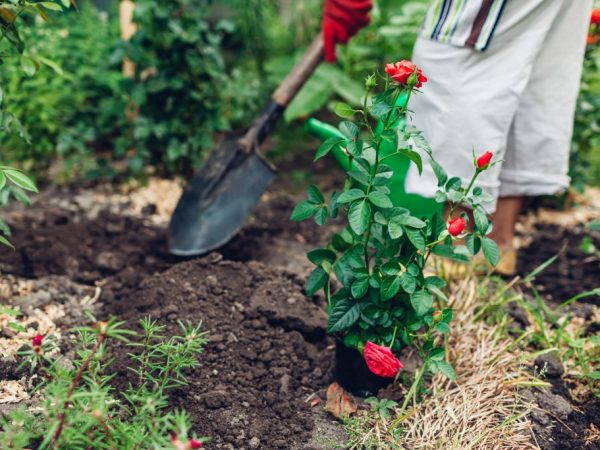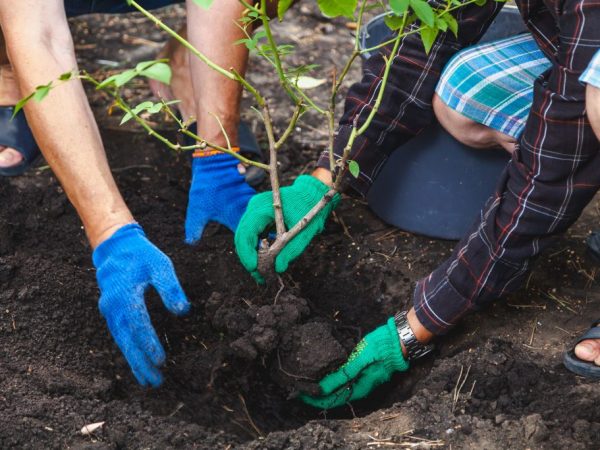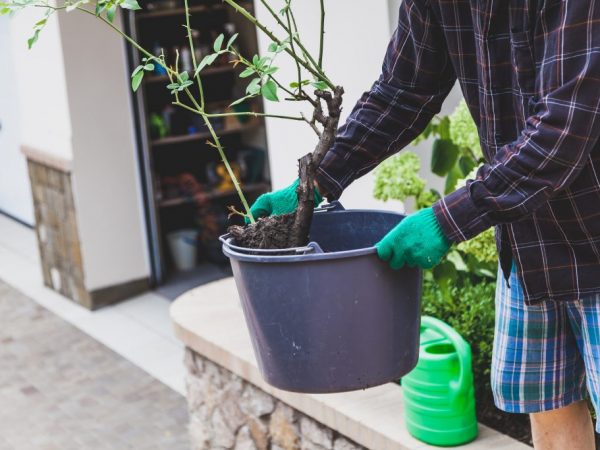How to transplant roses in the fall - a simple technology
Transplanting roses to another place in the fall is considered more favorable for the adaptation of the plant. During this period, the sun is no longer so active, and you can not be afraid that immature roses will suffer from burns, and an increase in the number of rainy days will contribute to rooting in a new area.

How to transplant roses in the fall - a simple technology
Purpose of the procedure
Periodic transplants are necessary for several reasons.
- Depletion of the soil. For a long time staying in one place, plants absorb nutrients, top dressing does not completely compensate for the deficiency.
- Overgrowth. Large bushes interfere with each other.
- Diseases. Parasites, fungus and harmful bacteria can remain in the soil even after successful treatment with drugs.
- Redevelopment in the garden or initially poorly chosen place. In this case, roses are transplanted when buildings appear that shade the plants, or, conversely, dismantle the old ones, which gave the bushes the necessary afternoon shade and shelter from the wind. Or the roses were originally planted in a very open area.
Optimal timing
Month selection
The ideal time to move roses is considered early autumn, namely the second half of August and early September. By this time, they have already faded to a greater extent, and the established weather is most favorable for rooting in a new area.
The procedure is recommended to be carried out on a cloudy and windless day. But it is important not to delay, because if you transplant later, there is a risk that the roots will not get stronger before the cold snap and the roses will die.
Roses can be transplanted in the spring, but then it will be necessary to take care of them more carefully and prevent flowering, namely, to cut off the buds.
In the summer, the procedure is carried out only in an emergency: if the plants are sick or grow in an unfortunate place. Manipulation during this period is carried out in cloudy weather in combination with pruning shoots and abundant watering.
Moon calendar
Roses need to be transplanted in the growth phase. Especially when the Moon is in the signs of Aries, Taurus and Gemini.
In 2019, days are considered auspicious:
- August: 3, 6–8, 9–12, 18–22, 26–27, 31;
- September: 1-6, 17-19, 23, 26-27, 29, 30.
Regional features
Transplanted plants take 2-3 weeks to take root. During this time, they will get stronger and will be ready for the first frost.
Depending on the climate of the region, the timing varies:
- In the south, replanting can be done until the end of November;
- In central Russia - until mid-October;
- In the northern regions, frosts come early, so it is better to have time to transplant in August.
Training
Seat selection

Choose your landing site carefully
The plot must meet the following criteria:
- Good lighting until noon, because in the morning there is active evaporation, and roses are less susceptible to fungal diseases.
- The presence of a slight slope, so rain and spring melt water will not stagnate and harm the root system.
- Protection from the north wind.
- Deep bedding of groundwater.
- Low soil acidity: Ph 6.0-6.5.
It is important to study the characteristics of the variety, since many roses (for example, the Mary Rose variety) cannot stand the midday sun and require planting in the shade.
In the next 10 years, you cannot plant roses on the site where cherries, quince or cinquefoil used to grow.
Digging roses
5-year-old roses are easier to transplant: young ones are not yet very strong, and older ones can grow strongly and it will be difficult to dig them out.
A couple of days before manipulation, the bushes need to be well watered. So the earthy ball, which protects the roots from injury, will hold on tightly.
Dig up roses, retreating 20-30 cm from the stem.
- First, they dig in with a shovel, then loosen with a pitchfork and cut off the interfering roots.
- After the bush is removed and laid out on burlap or other material convenient for transportation.
Climbing and curly roses should be wrapped in a cloth or tied with a tourniquet.
For digging up and transferring mature bushes, you can use a plastic bucket with a cut-off bottom.
- Vertical notches are made around the ground with a shovel and a bucket is strung on it.
- Then the rose is raised, the long and deeply ingrown roots are cut off, and then transferred.
Organization of planting pits
Planting holes need to be prepared 2-3 weeks before manipulation. So the soil will settle, and after planting, the root collar will remain level with the ground.
The size of the pits depends on the plant variety and is determined by the area occupied by the root system. It can be visually assessed using the following rule: the diameter of the root system is practically equal to the diameter of the crown.
Also, the dimensions depend on the technology:
- when transplanting a plant with an open root, the pits are prepared with the calculation of the free location of the roots, and the root collar should be flush or 2 cm below the ground level;
- if the roots are covered, the pits make twice the earthen ball.
It is recommended to lay a drainage layer of broken brick, expanded clay or river sand at the bottom.
Next, you need to add fertilizers and various additives, depending on the fertility and composition of the soil. For example, peat is added to sandy soil, coarse sand is added to loams, and chalk or dolomite flour is added to acidic soil.
Transplant technology

It is better to plant a rose with an earthen clod
First, you should prepare the soil, which will cover the roots. A soil mixed with humus and ash or a mixture of peat, turf and earth is well suited. You can also use commercially available rose primer.
With an earthen lump
The rose must be placed in the pit so that the surface of the coma is flush with the ground. At the same time, it is important to preserve the polarity, that is, to position the bush in relation to the south and north as it grew in the old place.
The voids are sprinkled with prepared soil mixture and tamped.
With age, roses form fewer suction roots, therefore, in order not to injure the existing ones, it is better to transplant the plants together with an earthen clod.
With bare roots
If the earthen lump cannot be preserved, for example, the bush will need to be divided, the roots are examined, the damaged ones are removed and placed in a mixture of humus and soil to prevent chapping. In this form, the plant can be left for several days.
After purchasing the seedling, it is recommended to immerse it in water for a day with Kornevin's solution or other stimulating agent.
- When landing, a small mound of earth is built at the bottom of the pit.
- A rose is placed on it, the roots are carefully straightened and watered with a root formation stimulator. In this case, it is important to ensure that they do not bend upwards.
- Then the hole is filled with prepared soil mixture to the level of the root collar of the bush.
- At the end, the ground is tamped, watered abundantly and hilled by 20-25 cm.
Follow-up care
In the first month after transplanting, the seedlings are shaded and the leaves are cut off. This is necessary so that the plant does not evaporate a lot of moisture and takes root better.
Re-pruning is carried out before the shelter for the winter.At the same time, it is important to observe the varietal characteristics of preparation for winter: climbing roses are cut by a third, and tea varieties are shortened by half, leaving 2-3 buds on the stem.
Follow-up care after moving is regular watering and disease prevention.
Summing up
For a successful transplant, follow these guidelines:
- roses should be transplanted in stages, paying attention to the preparation of both the bush itself and the soil;
- when digging up, you need to try to protect the roots as much as possible, namely: keep the earthen lump;
- do not neglect fertilizers;
- provide proper care after manipulation;
- do not replant often, preferably once every 5 years.

